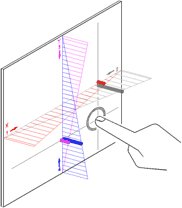New mobile device touchscreen tech demo’d
Apr 28, 2008 — by LinuxDevices Staff — from the LinuxDevices Archive — 1 views Wacom has announced a new touchscreen technology aimed at reducing problems associated with capacitive touchscreens in mobile devices. RRFC (reversing ramped field capacitive) touchscreens will use ramped voltages to deliver greater accuracy, easier finger operation, freedom from recalibration, and longer battery… life, Wacom says.
Wacom has announced a new touchscreen technology aimed at reducing problems associated with capacitive touchscreens in mobile devices. RRFC (reversing ramped field capacitive) touchscreens will use ramped voltages to deliver greater accuracy, easier finger operation, freedom from recalibration, and longer battery… life, Wacom says.
Despite their popularity, existing capacitive touchscreens have some limitations when it comes to portable devices, says Wacom. For example, the screens can sometimes become inaccurate when:
- The user is not grounded
- The user is not touching the tablet PC casing
- The tablet PC casing is electrically isolated
In addition, recalibration can be required when switching between battery and AC power sources, the company adds.
RRFC gets around the above problems by replacing the single, flat electrostatic field used by traditional capacitive touchscreens with four “ramped” electrostatic fields, says Wacom. The process begins by generating an AC voltage which is applied to two adjacent corners of the screen, and a DC voltage which is applied to the opposite two corners. Repeated for all four possible corner combinations, this forms a voltage ramp across the sensor, and a corresponding ramped electrostatic field.

Wacom's RRFC technology relies on ramped voltages
Source: Wacom
The actual touch point on the X or Y axis is determined via a ratio of the measured results from the two ramped fields that were generated on that axis. The signal data representing the touch is processed via a Wacom-designed ASIC, where proprietary algorithms for touch-point calculation are said to compensate for factors such as changing grounding conditions, noise in the environment, and ultra-low signals that cause jitter or drift.
RRFC technology has the following features and advantages, according to Wacom:
- Remains accurate, sensitive, and stable, even on battery power
- Responds to lighter finger touches than previous screens
- Operable via stylus
- Absorbs as little as five percent of available light, as opposed to 15 percent on traditional designs
- Resists scratching because surface is “tougher than glass”
- Requires calibration only once
- Provides accuracy up to the edge of the active area, +/- 2mm
Wacom says that RRFC solutions will use the same ASICs and MCUs (microcontrollers) as Wacom's existing touchscreens based on EMR (electromagnetic resonance). Therefore, manufacturers will be able to upgrade existing designs merely by replacing the screen sensor itself, according to the company.
Wacom did not provide a timetable for commercial availability of products based on its “patent-pending” RRFC technology. However, the technology will be on display May 20-22 at the Society for Information Display Exhibition in Los Angeles. Wacom will be located at booth #1129.
This article was originally published on LinuxDevices.com and has been donated to the open source community by QuinStreet Inc. Please visit LinuxToday.com for up-to-date news and articles about Linux and open source.